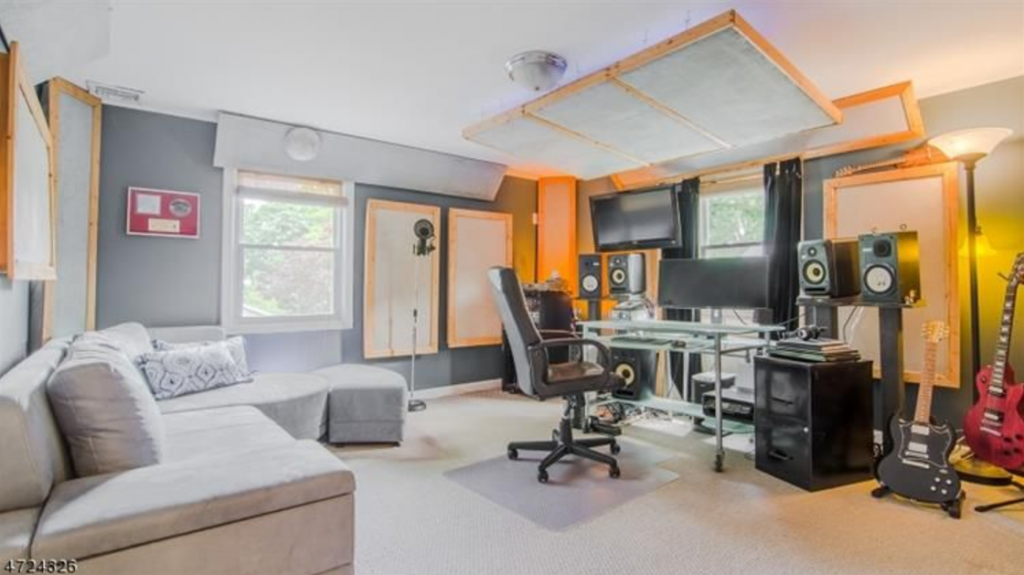[Links to building the sound panels below]
 Time flies when you’re having fun the old cliché saying goes. For me, five years ago, I was in the trenches for a good week going down a rabbit hole not knowing exactly where I would end up. I’m talking about sound panels – building sound panels that is; and if you’re anything like me, you’ve been in a few studios and loved the look and feel of those expensive looking ones on the walls.
Time flies when you’re having fun the old cliché saying goes. For me, five years ago, I was in the trenches for a good week going down a rabbit hole not knowing exactly where I would end up. I’m talking about sound panels – building sound panels that is; and if you’re anything like me, you’ve been in a few studios and loved the look and feel of those expensive looking ones on the walls.
 When I moved into our new house, my goal was to create a project studio where I could plain and simply put, have fun. My jobs before Cakewalk at Elektra Records and Capitol Records allotted me enough pressure-cooker studio situations to last a lifetime, so this studio was about doing things I wanted to do, when I wanted to do them, and maybe also making some college money on the side for my boy Mack (now 8).
When I moved into our new house, my goal was to create a project studio where I could plain and simply put, have fun. My jobs before Cakewalk at Elektra Records and Capitol Records allotted me enough pressure-cooker studio situations to last a lifetime, so this studio was about doing things I wanted to do, when I wanted to do them, and maybe also making some college money on the side for my boy Mack (now 8).
Fast forward to the present and as life will have it, we are leaving this house and moving into another. Fortunately, the move is a good situation to be in, but taking down the sound panels from these walls is bitter-sweet as I have had some great projects in here. If sound panels could talk I wonder what they would say? “Jimmy, that couch you use for a base trap has got to go.” Or, “Dude, you are killing me at 2.5k with that hot mess.” Or even, “Another compressor on the lead vocal – really?” Haa… But seriously speaking, as someone who cares about music, artists, our industry and sound recording in general, I must admit that I was feeling a bit nostalgic breaking down the room.
 On the non-wistful side of the coin, I can report back after 5 years that these panels have really served me well, and that’s the main reason for this post. In fact back when I built the panels, I thought it would be a good idea to document my experience for other musicians. I figured there had to be others in my shoes who wanted the aesthetic look of something a bit more appealing than those egg crate foam pads (not that there is anything wrong with those at all!), but didn’t want to shell out the big bucks for the professionally build ready2go panels you can order online. At the bottom of this blog you will find a link to the full series of info-blogs that I created while making the panels.
On the non-wistful side of the coin, I can report back after 5 years that these panels have really served me well, and that’s the main reason for this post. In fact back when I built the panels, I thought it would be a good idea to document my experience for other musicians. I figured there had to be others in my shoes who wanted the aesthetic look of something a bit more appealing than those egg crate foam pads (not that there is anything wrong with those at all!), but didn’t want to shell out the big bucks for the professionally build ready2go panels you can order online. At the bottom of this blog you will find a link to the full series of info-blogs that I created while making the panels.
 Not only did these panels serve me well for their visual appeal, but they really made this small room sound great. Like any room, it took a little bit to understand it’s quirks, but after a few mixes I was able to get my ears around the whole “mixing and producing at home” thing. I was fortunate enough to get a few productions for ESPN picked up out of here, did a few EP’s for artists like Jodi Good and Peppina, and wrote and produced some songs for indie films which all ended up in festivals. I was also able to have fun recording my son while showing him a bit of the ropes in the production arena, while also reproducing a hidden-track single off one of my best childhood friend’s record – the accomplished Boston based Conor O’Brien. There were also a few late memorable music nights with my Grammy-nominated neighbor and friend across the street Alan Ferber and his wife Jody Redhage — all in all — the studio absolutely served its purpose.
Not only did these panels serve me well for their visual appeal, but they really made this small room sound great. Like any room, it took a little bit to understand it’s quirks, but after a few mixes I was able to get my ears around the whole “mixing and producing at home” thing. I was fortunate enough to get a few productions for ESPN picked up out of here, did a few EP’s for artists like Jodi Good and Peppina, and wrote and produced some songs for indie films which all ended up in festivals. I was also able to have fun recording my son while showing him a bit of the ropes in the production arena, while also reproducing a hidden-track single off one of my best childhood friend’s record – the accomplished Boston based Conor O’Brien. There were also a few late memorable music nights with my Grammy-nominated neighbor and friend across the street Alan Ferber and his wife Jody Redhage — all in all — the studio absolutely served its purpose.
 Upon taking these panels down for transporting one more thing occurred to me; they are really light! This is something I overlooked when I was building them, but a magnificent surprise now that I have taken them off the walls and prepared them for transporting to their next gig. They key element to them weighing so little was using Home Depot “furling strips” for the main framing, and other light wood for the chassis.
Upon taking these panels down for transporting one more thing occurred to me; they are really light! This is something I overlooked when I was building them, but a magnificent surprise now that I have taken them off the walls and prepared them for transporting to their next gig. They key element to them weighing so little was using Home Depot “furling strips” for the main framing, and other light wood for the chassis.

